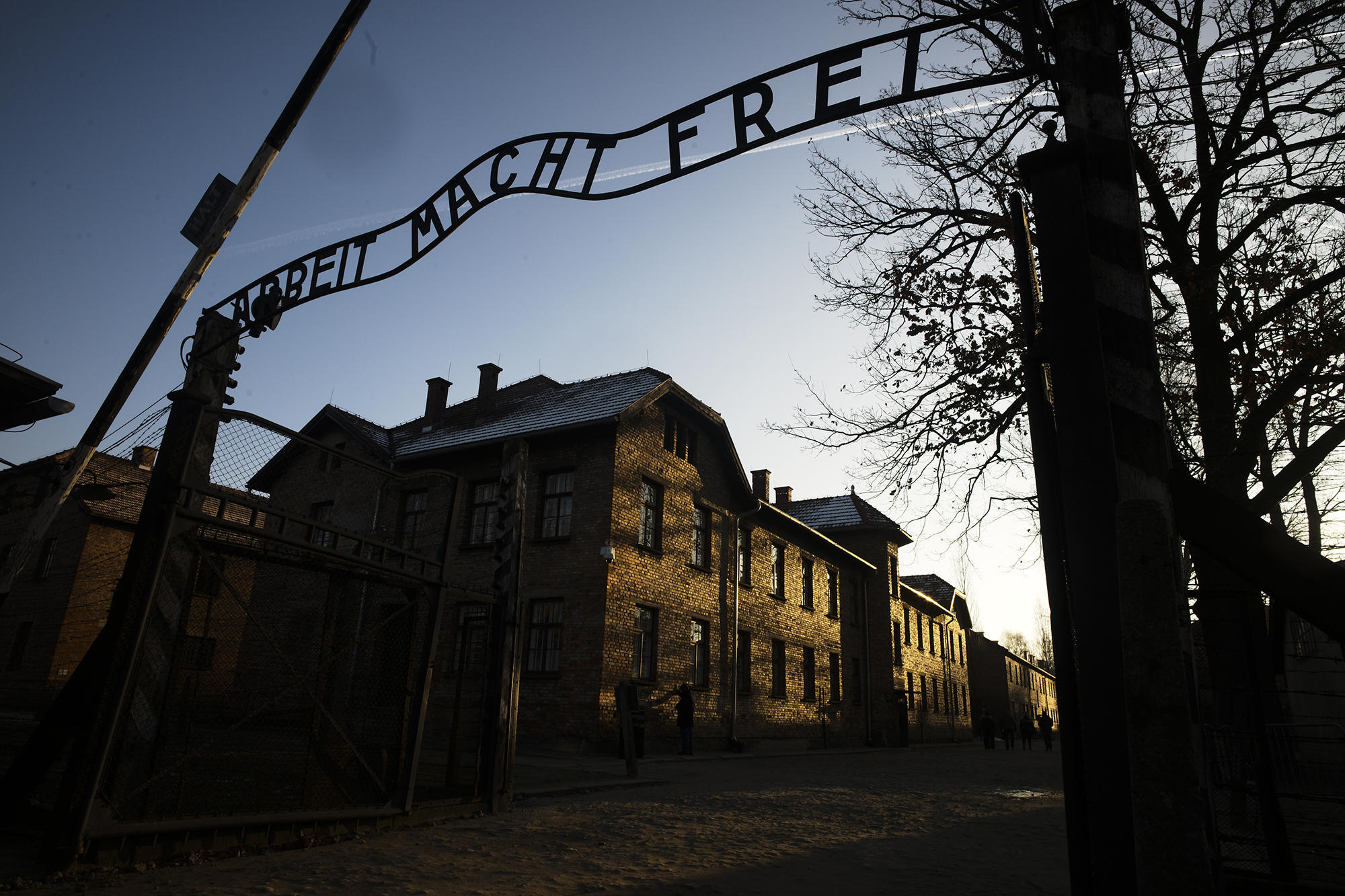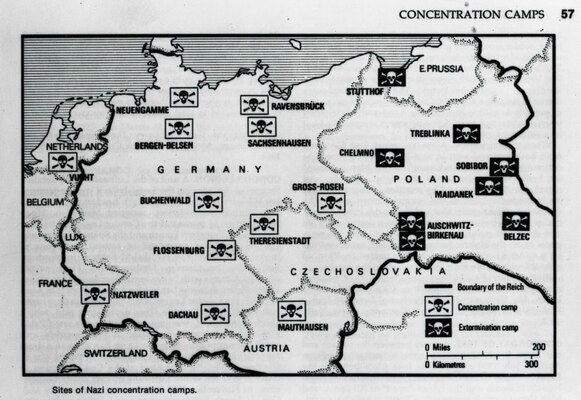The Truth About Auschwitz I
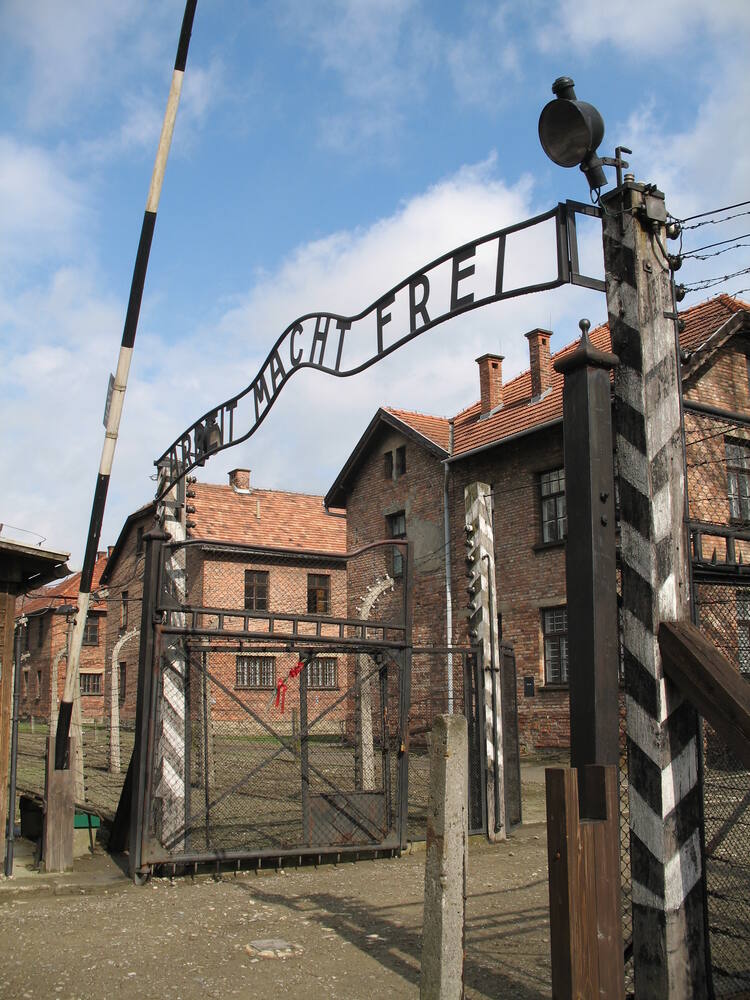
I STARTED OUT just like you. I read from the same Illuminati text books and was exposed to the same blinding propaganda. The Godvernment and my diploma had me convinced that the Germans murdered 6 million Jews in a few short years as part of their final solution. Approximately 3 million of those were accomplished in gas chambers deceptively disguised as shower rooms. But that is a lie. There is irony to the gas chamber story in that they were in actuality shower rooms, not gas chambers, and you are the one being deceived rather than the Jews. It’s okay, they had me believing “the swap” at one time too. We are all equal inheritors of the lie. Our Slave Masters simply don’t expect you to ask logical questions. And yet, here you are for one reason or another—seeking. Welcome. The ending to this story is that nearly everything we’ve been told about the Holocaust was a flamboyantly royal hoax. You are under no obligation to believe the official narrative. You too can refuse your inheritance. Just hand the gift bag of lies back to them. And while you’re at it, be sure to tell the Godvernment exactly where they can shove it.
Now that I have your attention, let’s get a few obvious facts out of the way. There was no Master Plan to exterminate the Jewish race. No order was ever found from Adolf Hitler or Heinrich Himmler, nor was it administered by Adolf Eichmann or any other Nazi officer. You have simply been told the marching orders were given without ever being shown the paperwork. And if there’s one thing the Nazi’s loved, it’s paperwork. None of that will be further discussed here. I merely bring it up as a matter of peripheral vision.
Though there are nearly two dozen other concentration camps to tend to, the purpose of this paper is to finally cross under the infamous “Arbeit Macht Frei” (Work Sets You Free) sign for a closer inspection of the Big Guy, as Auschwitz has become the very embodiment of the Holocaust narrative. Flossenburg, Mittelbau-Dora, Buchenwald, Dachau, Neuengamme. Nobody brings up those names, and with good reason. You see, I wrote my first paper on the Holocaust nearly a year ago, and whenever the subject comes up around the campfire, there is always seemingly somebody who asks: “Yeah, but what about Auschwitz?” See what I mean? I expect this to be a two part paper. I call it The Thing About Auschwitz I, as we will only be dealing with the labor camp known as Auschwitz I. If you expect me to address the labor camp known as Auschwitz II, then you will have to wait another week for The Thing About Auschwitz II.
Originally, just about every labor camp in Germany was advertised to us as a center for extermination. Bergen-Belsen is still heavily employed for the Holocaust narrative, but if you’ve read my paper on Anne Frank, then you know that’s an easily proven lie. Anne Frank. In short time, every last concentration camp under control of the western allies were investigated and found to be untrue, despite a global media effort to the contrary. Gee, I wonder who owns the media. But you already know it’s the Zionists, don’t you?
Isn’t it convenient how the only remaining death camps were in Poland, east of the Berlin Wall, and therefore unavailable to public inquiry for nearly fifty years? Auschwitz was one of them. Also, the mere fact that both western allies and the Soviet Union were apparently pitted against the other but simultaneously in on the same deception is probably none of my business.
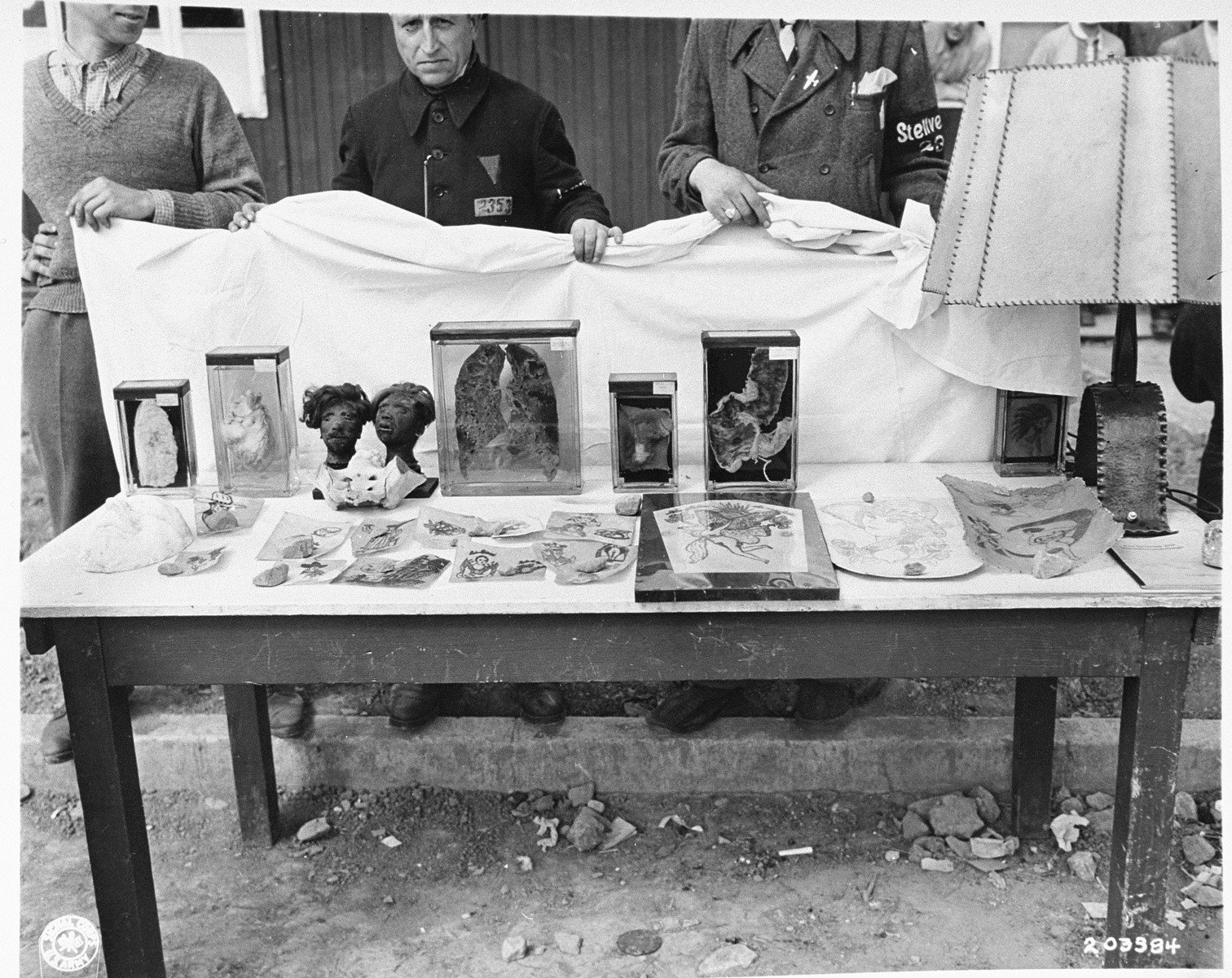
At Buchenwald, the US Army’s psychological warfare division set up a table with shrunken human heads and a lamp shade and told Germans it was made out of the skin of prisoners. The story goes that Ilse Koch, wife of the commandant of Buchenwald concentration camp, had possessed lampshades made of human skin, and had specifically tattooed prisoners killed in order to use their skin for this purpose. Ridiculous.
Already, I’ve deviated from our arrival at Auschwitz, but only to bring up a valid point. Even the official narrative admits now that the human skin story was a fabricated hoax. Did you hear the one where Jewish prisoners were turned into bars of soap? Huh…? Show me a single member of the Schutzstaffel who would in his right mind lather his apple bottom with something like that. Hearsay is a hell of a thing, especially when Intel is playing a game of Chinese whispers, wouldn’t you say?
What else were we lied to about? Let’s find out.
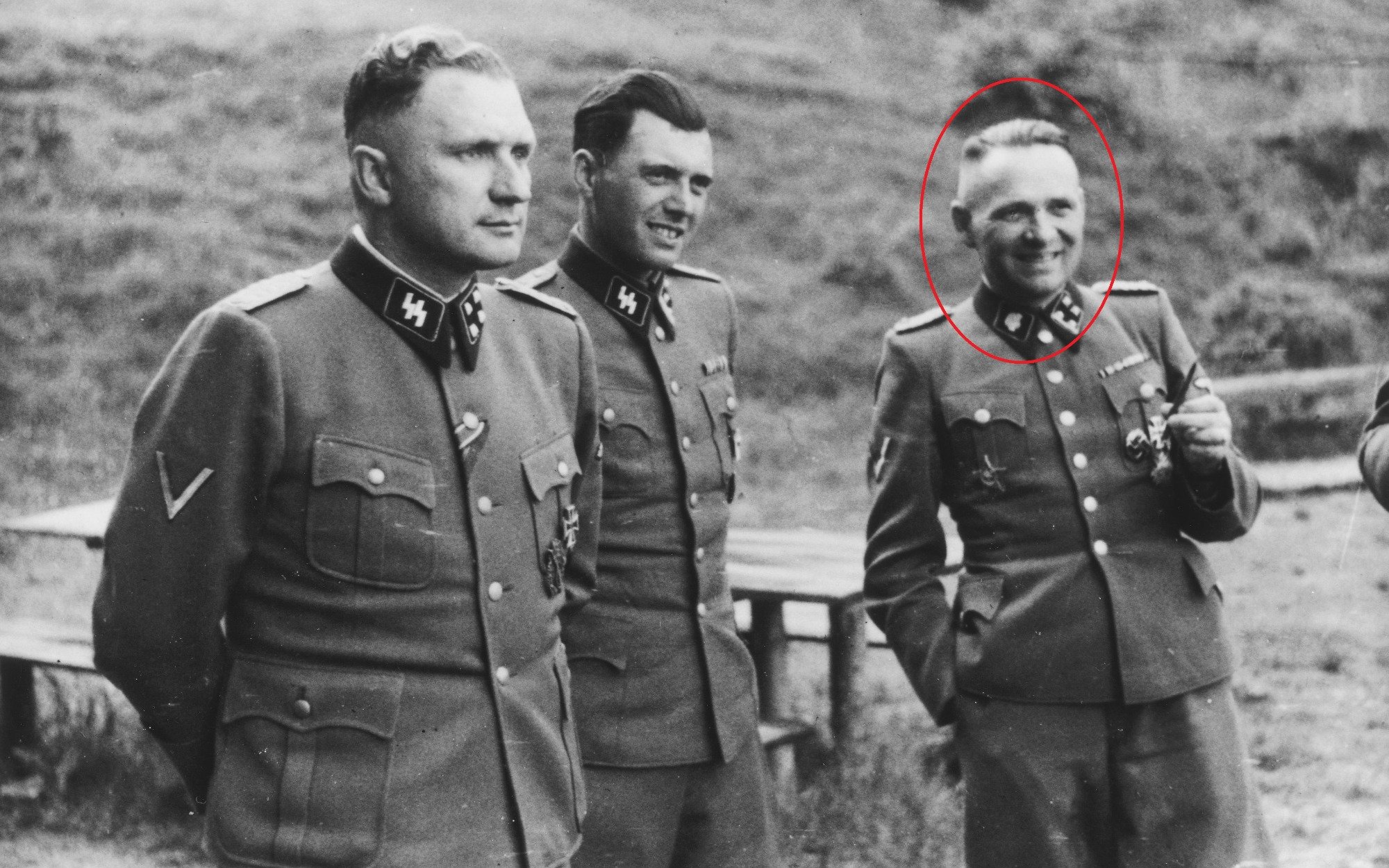
Auschwitz I
THE FIRST camp at Auschwitz was dubbed Auschwitz I and was started as a POW camp for the purposes of holding some 10,000 Polish soldiers during the campaign of 1939. Heinrich Himmler approved the site in April of 1940 and then personally endorsed Captain Rudolf Höss as the camps inspectorate. Höss (pictured above with the egg-shaped halo) oversaw the development of the camp, tasked with converting some 22 dilapidated brick barracks, surrounding a large square once used for the breaking of horses, into a passable prison camp. On May 20, the first thirty prisoners arrived from Sachsenhausen.
Within three weeks, a mass transport of some 728 political prisoners, including Catholic priests and Jews—arrived from Poland. But that was still only the beginning, as the chemical group IG Farben selected Auschwitz in 1941 as a major industrial site, mainly for the production of rubber. This was wartime, and the Germans needed workers like they needed rubber, not corpses. Höss soon found himself with a camp population in excess of 30,000. The Nazi’s invasion of the Soviet Union had something to do with that, as thousands of Russian soldiers began pouring into the labor camp. A rapid wartime population growth ensured that the spread of disease would soon became an issue. Naturally, deaths ensued. Höss therefore ordered the building of a crematorium in Auschwitz I, later to be known as Krema I. The rest is history.
The gunshot sprint of the Holocaust narrative takes its stride here, but only because our Slave Masters don’t expect you to use common sense. The existence of a facility intended to hygienically dispose of a body is only as much proof of a final solution as it is for our own hospitals and prisons, most of which come equipped with an in-house crematorium. No wonder Nazi officers were looking around at their trial in Nuremberg, listening in to the accusations flung at them with bezongaled faces, going, “What the fubar?”
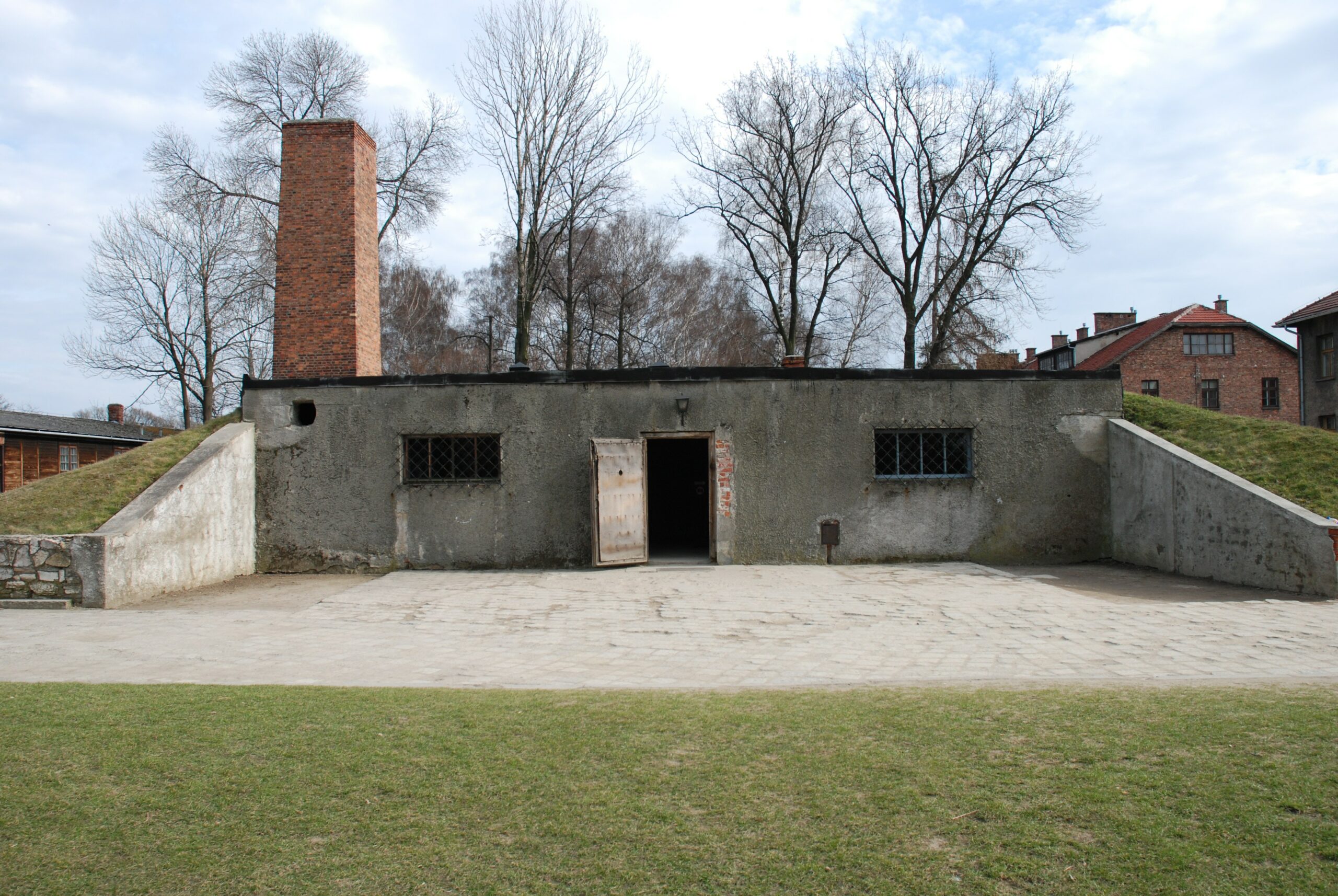
OBJECTIVE visitors would not arrive to the camp until the fall of the Soviet Union in 1990, as they could now raise their hands and ask questions without having guns pointed at their heads. That is to say, there is good reason why all the death camps were put behind the Berlin wall. For nearly 50 years, the Holocaust myth could not be challenged. Those visiting Auschwitz today are told the crematorium building, specifically the morgue, was in actuality a gas chamber. Specifically, that it was converted into a temporary gas chamber in August of 1941 until the day when it wasn’t, as the end of The War saw it once again converted into an air raid shelter. The idea is that Nazi soldiers would inconspicuously insert Zyklon B into slots, by which the gas pellets are supposed to have been administered, cleverly hidden out of sight from the gullible, so that cyclic herds of Jews only believed they were entering to take a shower. This is the building where it happened. You’re looking at it.
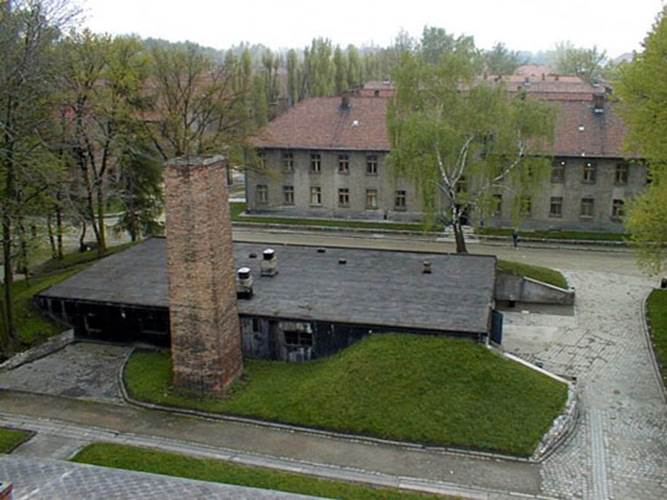
Go ahead. Study the photo. Take all the time you need. There’s a problem. Several of them, actually. The most obvious is how close the gas chamber at Auschwitz I sits in proximity to its other buildings. Take a mental note of that, because we will turn to its surrounding buildings in a little while. Not so inconspicuous are the two stumps on the roof, where the Zyklon B was reportedly dropped. The present trees in this photo would have been either non-existent or much smaller then. So, blinders would have been a minimal.
Initially, we were told that 4 million people, most of them Jews, were murdered here at Auschwitz. In this small building? Train after train pulls up on the rails, entire cyclic herds of Jews are crammed into this small space, and we are expected to believe that nobody noticed a Nazi gassing the Jews from the rooftop, despite clearly being visible to the entire camp. You’d think somebody would notice. Maybe not immediately after grandma went missing. But by the time your uncle and aunt, mom and dad, and half of your siblings and cousins never returned from the “special” shower, there would be someone, just one person who might exclaim: “Oh my god! That’s no shower house. We’re being gassed!” But no.
The next issue is rather obvious, and a glaring problem, once you see it. Can you see it? I do. The chimney isn’t even connected to the building. Certainly not to the two ovens inside. A row of grass can be found between the two, and you figure somebody in the world takes the time to mow it. Why would the Nazi’s design an industrial sized chimney, apparently for the purposes of burning Jews, and not even line it up right with the building? They wouldn’t. Those early visitors to Auschwitz started noticing that it wasn’t even connected to the ovens on display inside.
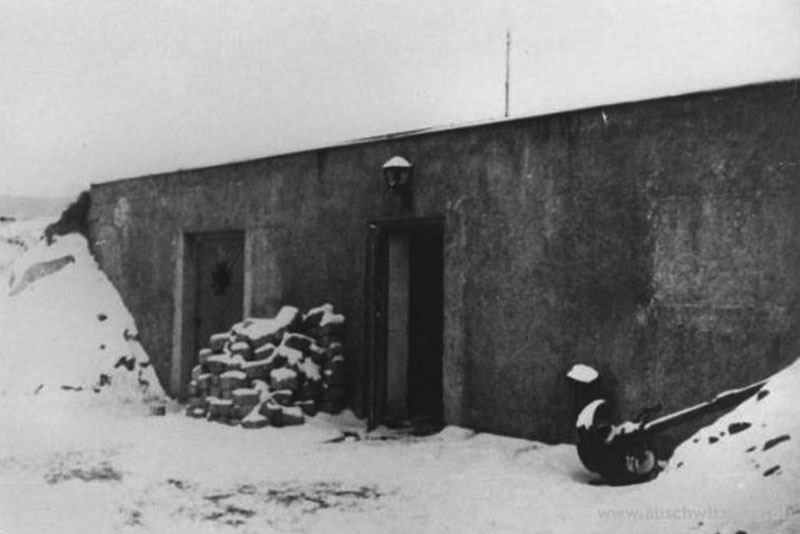
But wait, what’s this? Looks like the “Museum curators” of Zionism decided to give the old shower house at Auschwitz a face lift in more ways than one. There’s no chimney. What the fubar? The photo was taken in 1945. Snow litters the ground, and lot’s of it. The Hitler death hoax went down in April (of course it would), and so, unless it snows in August in Poland, then we can presume this was taken in the colder months, when the Nazi’s reportedly clung to delusions of grandeur. Meaning, they still had Jews to kill. Then why no chimney? Must have been a later addition, long after The War was won. How convenient.
Also, one door was removed. They’ve turned it into a window. So many revisions. Kind of makes one wonder what will happen if we enter the door and take a peep inside. Should we? Our high school history teacher probably wouldn’t approve. Aw, hell. Let’s have a go at it, anyways.
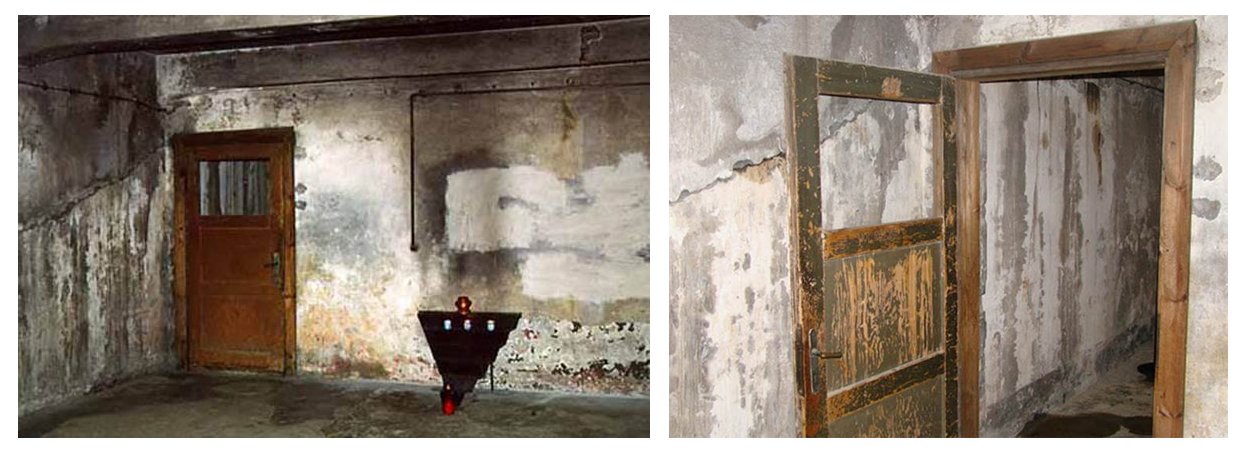
Mm-hmm, I knew it. Yet another problem. Might as well plant your Buzz Aldrin moon flag right here, because we’re standing inside the so-called gas chamber at Auschwitz I, and nearly a third of that door in the rear of the room is made of glass. Because apparently the Nazi’s liked to watch and not one Jew in 6 million had the bright idea to smash it in. Perhaps they only wiggled the door handle, found that it was locked, and gave up hope. Scratched at the wood with their fingernails rather than kick it down. How many people did they pack into these rooms each and every hour? We’re told hundreds at a time, much as they would in the popular attraction at any amusement park. Or else how do you come up with that magic number?
How thick does that door looks to you? No, not the frame. It’s interior looks to be less than an inch. You wouldn’t need a hundred desperate people to kick it down. One or two desperate people could do the job. Their shoes would have already been removed for “the shower,” but if it came down to a bloody foot or a broken toe and the life of another hundred people, the choice would be obvious. You will tell me the Nazi’s would have killed me anyways, soon as I punctured my ankle through it. Sure, but disrupting their operation, even for a single day, might have saved several thousand souls, if we’re going by the official numbers. At least they’d be pressed to hang a proper door up on its hinges. Take another look. The door isn’t even air tight. You figure that to be a problem.

Speaking of non air tight places, our home inspection just keeps getting worse. A tourist of Auschwitz I can expect to find manholes and a shower drain in the gas chamber. Seriously, are you trying to tell me, Museum Curators, that a fake shower came equipped with an actual working shower drain? I’m getting too old for this shit. The gas would have escaped. Not only would it have escaped, the gas would have seeped into the rest of the building.
Tourists are then led into the crematorium without ever leaving the building. This is obviously important to the narrative, as the Nazi’s needed to dispose of the bodies—thousands upon thousands of bodies—without being seen by the next party anxiously awaiting their shower. But wouldn’t you know it, somebody took a sledgehammer to the wall. More home remodeling, hmm? Soviet spooks were penny pinchers budget, apparently, as they didn’t even bother framing a door. A gas chamber door leads directly into the room which contains the two ovens. Remember how I said the chimney isn’t even connected to the two ovens? It’s because the ovens are, according to Museum Curators, reconstructions. Right. Even if the door were air tight, no Nazi in his right mind couldn’t open it in such rapid succession without stomaching the thought of gas escaping. The room would have exploded.
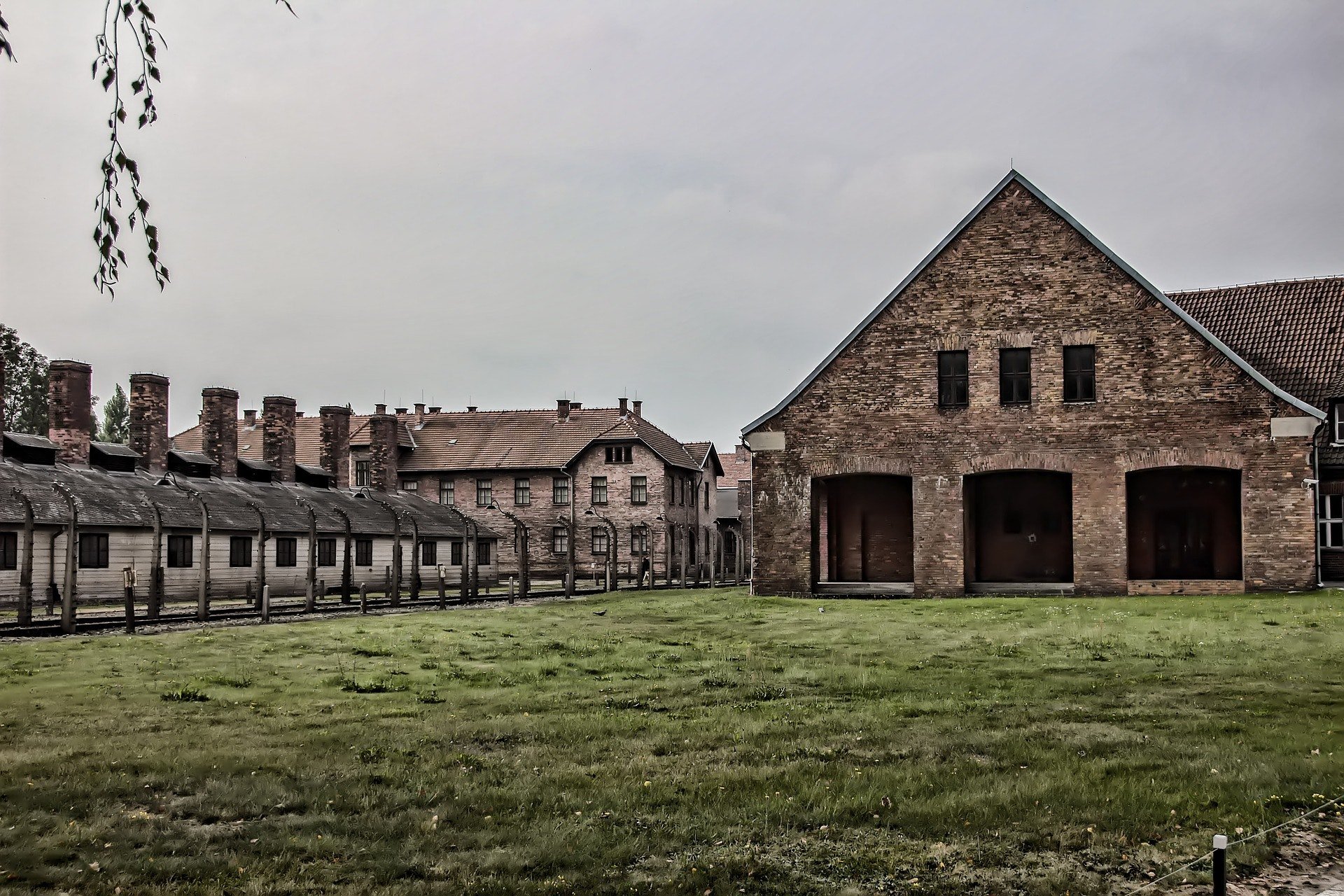
MOST PHOTOS of Auschwitz focus upon the photogenic Work Sets You Free sign arched over the entrance gate, choosing the buildings stage left for a background. While on another reconnaissance mission in The Matrix, I had a terribly difficult time finding a picture of the building stage right of the sign. And that is perhaps because the building on the right is a massive bakery, containing row upon row of chimneys. You should immediately be asking yourself why an extermination camp would include something like that. I mean, if you wanted to kill an untold millions of Jews and bullets were too expensive, stop baking them bread. If the Germans wanted to exterminate the Jews, then why did they even haul them in boxcars to camps? However, since they obviously did, why not just round them up into a fenced-off field and starve them to death? It sounds cruel, but so are the claims which The Government is making.
Sure, prisoners need bread and broth, if they’re expected to work. But before you try to explain the evils of holding people against their own free will in a labor camp, try not to make the Nazi’s an exemption to the rule. There is nothing unusual about using Soviets, Jews, and other political or military prisoners for forced labor, as The War was being waged and the Germans needed people for the production of their synthetic rubber. You know who else made rubber? At Manzanar in California, imprisoned Japanese worked with plants which were used to create rubber. Most of whom were American citizens.
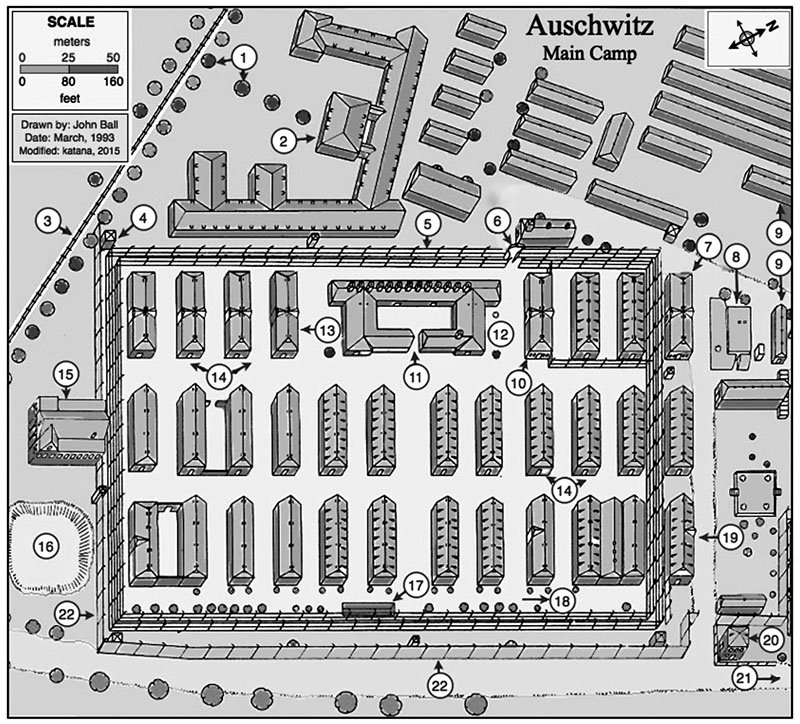
This map of Auschwitz I is the best that I have found. It was drawn by somebody named John Ball and is provided by Peter Winter, author of The Six Million. Much of my current research originates with Winter anyhow. I say best for a reason. And that is because, upon closer inspection, no other mapmaker wants you to know that a bakery is only the beginning of what Auschwitz offered its residences. Numbers 1 through 22 direct us to the following.
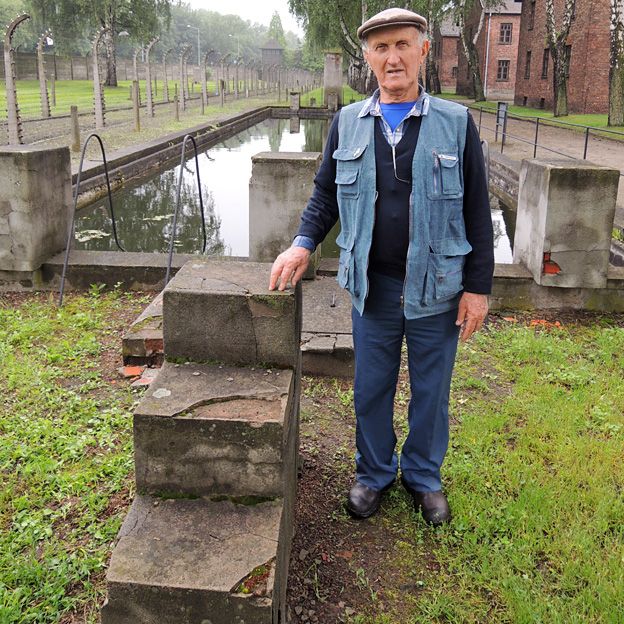
-
- Trees
- Administration building
- Rail spur
- The first of nine guard towers
- Parallel wire fences
- “Arbeit Mach Frei” Gate
- Hospital with surgical unit
- Crematorium I
- Workshops for woodworking and sewing;
- Brothel and library
- Place where the orchestra played
- Kitchen with 13 coal-fired stoves
- Post Office
- Three-story sleeping barracks
- Theater for music and drama
- Sand and gravel pit
- Swimming pool
- Birch Alley (Birkenhaller)
- Camp administration offices
- Camp commandant’s residence
- Sola River road leading to town of Auschwitz
- Cement fence around two sides of camp.
So, let me get this straight. Auschwitz I offered a swimming pool, as well as a musical revue. Hard to practice for the play when you’re slaving away in the rubber factory. You will want to take note of the fact that the kitchen is listed as having 13 coal-fired stoves. I’m willing to bet it’s row of chimneys were actually connected. And another thing, you won’t often hear about the swimming pool. In fact, I can’t recall a single holocaust narrative in my upbringing where the swimming pool was recollected. And that is because the entire Holocaust narrative, complete with downcast faces and militant marches to the shower house, sounds ridiculous when it involves children splashing in a pool. Museum Curators have kindly put a sign up which assures us that the pool was a “fire brigade reservoir built in the form of swimming pool.” Right. Never mind the steps which clearly depict where the diving board once stood. Nazi’s certainly had a sense of humor, didn’t they? In case of fire, be sure to dive in head-first. Blow bubbles on your way out. Ah yes, the old diving board. Here we see a picture of someone recounting his youthful days in Auschwitz, when he played Marco Polo with the fire brigade.
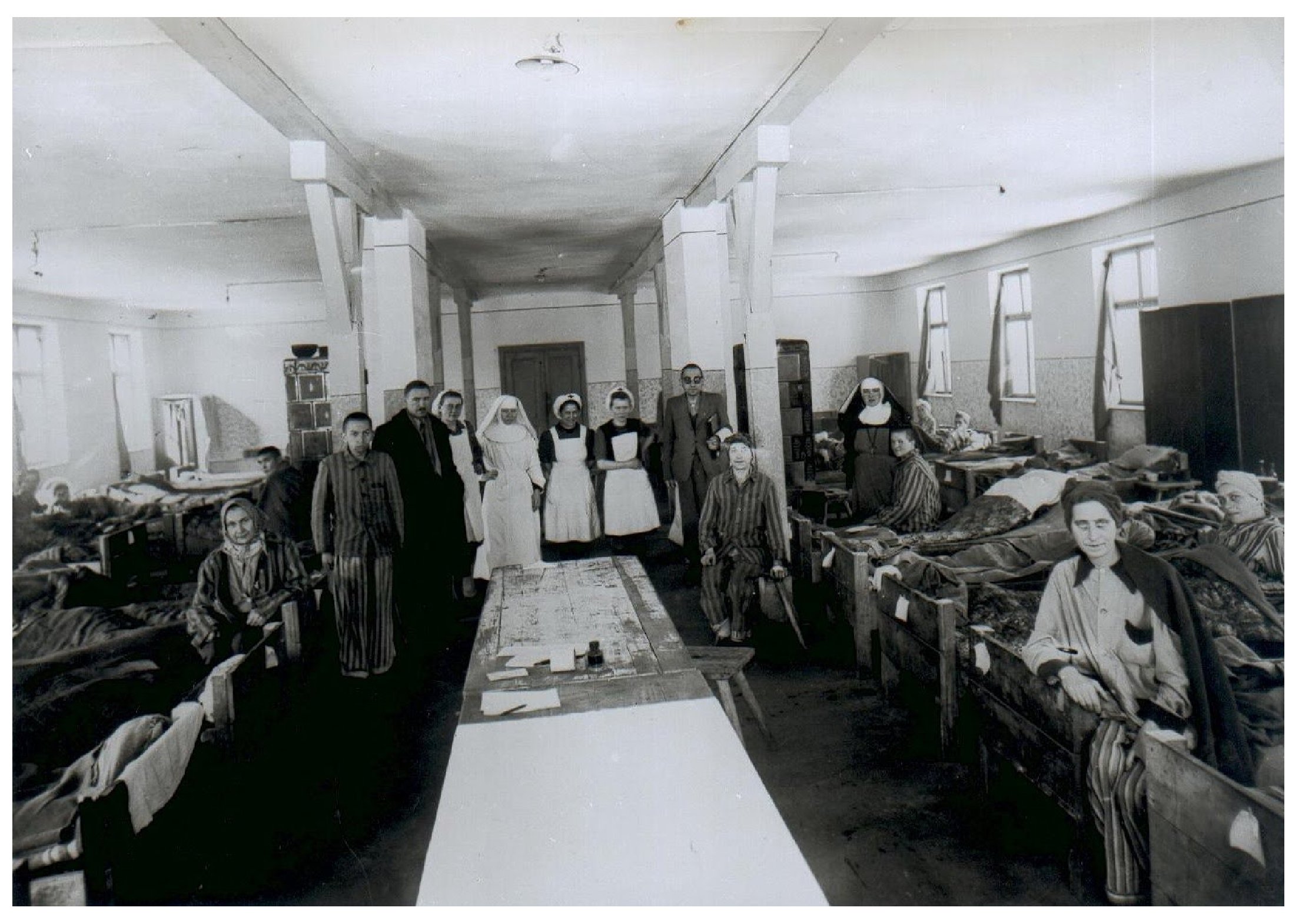
Funny thing about a hospital is that you would think it was there to make people better, especially since the one in Auschwitz came equipped with a surgical facility—but no. We have already established the fact that most prisons and hospitals include a crematorium. As one would naturally expect, the hospital at Auschwitz I was a hop and a skip from the crematorium. A stone’s throw, really. But I’m sure that’s all just a coincidence.
Here we see a picture inside the first floor of the hospital ward in Auschwitz. It was taken by somebody named Stanislaw Mucha—a Jewish name. Since when were Jews handed cameras? We are told it is February or March of 1945. The War would be over in a month. Crematorium I is right beyond those sunlit windows, and patients are smiling. At some point during their bed stay, you’d think one of them would catch a Nazi in the act of pouring Zyklon B into those two rooftop slots and then warn the constant line-up of Jews on the walkway: “I don’t think that’s a shower!” It’s not like they’ve blackened out the windows. Is that a a pair of nuns and the Red Cross assisting the sick? Mm-hmm, their uniforms wear the mark of the Red Cross. Was the Red Cross in on it too?
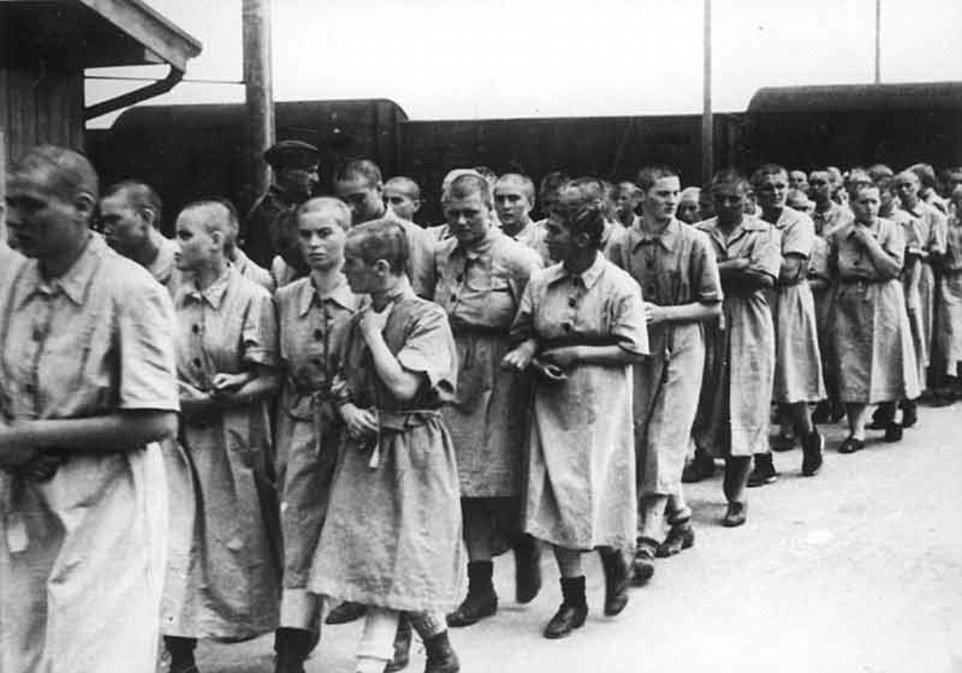
Also, the library doubled as a brothel. I’ll let you figure that one out, as sex education likely didn’t involve books. We are told that the Auschwitz doll house was “one of the lesser-known horrors of WWII,” and that it was a sick and sadistic plan of the Nazi’s to make them work harder, by rewarding them with bed rights. You mean the Nazi’s actually allowed for men and women prisoners to have sex with each other? Oh dear. Apparently, Nazi officials observed their bed behavior through a peephole. It was done in order to enforce a “missionary position” policy, because nothing says Nazi like an actual Nazi bursting through the door, screaming: “No sex for you!”
Don’t American prisons offer conjugal visits? Some conjugal visits can be a scheduled period ranging anywhere from several hours or days. The same Holocaust narrative insists that women were only allowed to have sex if they were healthy and pretty, and that they were furthermore first checked by camp doctors before being accepted, and why would they do that? I thought everyone was getting gassed in the morning. Why not just throw in an unhealthy, unattractive woman and call it a day?

And now we find ourselves in a dentists office. We are once again told it is Auschwitz. This is getting ridiculous, as not even the British had it that good. Why even bother fixing someone’s teeth when you plan on sending them up in a cloud of ashes the following morning as a welcoming gift to the Boeing B-29 Superfortress? I’ll say this again, it was only a crematorium. Some women were working in brothels and others were getting their bed-tuck by the Red Cross, while outside on a warm summer day, children were taking a plunge off the diving board. But nobody was getting gassed.
Everything we’ve so far seen defies all belief, but the best lies are designed that way. Deny your own observations in order to accept the official narrative. Push those uncomfortable feelings even deeper into your gut and let the intended spell do its work, or else face the consequences. They will accuse you of becoming a dreaded anti-Smite, and who wants that? The Intel community has set up a series of manufactured boys clubs like the KKK to show you what a Holocaust denier becomes. All we are ever given is the illusion of choice. The official narrative is set up that way. Te entire Construct is a lie. Next week we’ll take a look at Auschwitz II, and if you still choose to believe the lie but the cognitive dissonance becomes a headache, then you needn’t worry. They have a daily prescription of blue pills for stuff like that.
Noel
